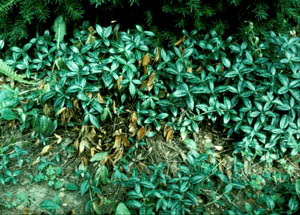Persistent Periwinkle Problem | |
|---|---|
| April 25, 2007 | |
|
Periwinkle (Vinca) is grown as an evergreen or semi-evergreen ground cover in Illinois. It is popular because it provides a pleasant, soft, green ground cover in shady locations. Unfortunately, a fungal disease problem of periwinkle can be very persistent once it invades a site. This disease is called Vinca stem blight. If you have had problems with this disease in the past, now is the time to take action to manage the disease for 2007. Vinca stem blight is caused by a fungus named Phoma exigua var. exigua. The fungus thrives in moist conditions such as those found in dense plantings of ground covers, especially in the spring when there is plenty of moisture and succulent tissue. Black lesions may develop on the leaves and stems first, often girdling and killing runners. Stems and foliage then become brown as they are killed by this fungus.  Those infected last year are hosting the fungus now. If you see the black lesions, look for pinhead-sized fruiting bodies of the fungus in the black tissue. A look-alike disease, Rhizoctonia root rot of vinca, causes top decline by rotting the roots. It may also cause black stem lesions, but you won’t find fruiting bodies in the lesions. Not sure which disease is present? Look for these fruiting bodies in the black stem lesions. Dig up an infected plant and look at the root system. Phoma does not cause a root rot. Vinca stem blight is difficult to control, but you can make some headway right now. Work with plants only when they are dry. This helps minimize disease spread. Remove infected plants, including old runners that may be hidden among other plants. Clean out dead leaves to open up air movement in the bed. If irrigation is needed, water the soil rather than the foliage. There are many fungicide options to protect new growth. Those with some systemic activity and listed in the 2007 Illinois Commercial Landscape and Turfgrass Pest Management Handbook include 18 Plus, 26 GT, Banner MAXX, Chipco 26019, Compass, Cygnus, Heritage, Iprodione, ProPensity, Propiconazole, Savvi, Sextant, Spectator, and Zyban. There are also protective contact products available. Fungicide applications should be initiated when the disease first appears. For more information about this disease, refer to Report on Plant Disease, no. 640, “Stem Blight of Vinca” (http://www.ag.uiuc.edu/%7Evista/horticul.htm) or review HYG Pest news 2006, no. 11. |